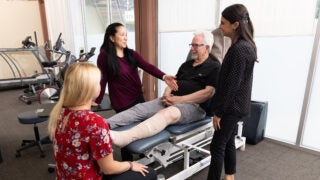Homelessness linked to higher risk of death from COVID in L.A. County, study shows
In Los Angeles County, 256 homeless people died of COVID-related causes in a 22-month period — a rate more than twice that seen in the general population.
People experiencing homelessness in Los Angeles County who contract COVID-19 are 2.35 times more likely to die than someone in the general population, according to a new study by USC, UCLA and the county.
The study, published in JAMA Network Open this month, suggests that homelessness is a unique risk factor for COVID-related deaths and that the likely cause is the vulnerability brought on by accelerated aging among the homeless, the researchers said.
“This work shows that COVID-19, like many infectious diseases, is what we call a ‘housing-sensitive condition,’”said co-author Benjamin Henwood, a professor at the USC Suzanne Dworak-Peck School of Social Work. “More aggressive housing and homelessness prevention interventions are needed to mitigate these conditions.”
Initial concern about COVID and the homeless population
When the pandemic hit, concerns about L.A. County’s unsheltered homeless population — the largest in the country — led to a successful call for federal funding to place people in protective housing programs, reduce shelter density, conduct contact tracing for COVID and prioritize vaccinations for homeless people. The hope was that the pandemic would have no worse impact among the homeless than among the general population.
That was not to be. Researchers from USC, UCLA and the L.A. County Department of Public Health tallied 256 COVID-related deaths among an estimated 52,000 people experiencing homelessness between Jan. 1, 2020, and Nov. 1, 2021.
“Excess risk of mortality for people experiencing homelessness versus the general population was observed across all age groups, among male individuals and female individuals, and among Black, Hispanic and white subpopulations,” said Randall Kuhn, UCLA Fielding School of Public Health professor of community health sciences and a co-author of the research.
People between the ages of 35 and 44 experiencing homelessness were at particular risk: They were 3.65 times more likely to die from COVID than their counterparts in the general population. The higher mortality rate may have been due to differences in vaccination, Henwood said, with older individuals more likely to get a vaccine.
Researchers used data from clinician reports, death certificates, medical examiner reports and vital records. Confirmed COVID deaths included those with a positive COVID test and either COVID listed as a cause of death on a death certificate or the date of death occurring within 60 days of the first confirmed test (and up to 90 days if the patient was intubated). Sudden or unexpected deaths due to violence, drug overdose, etc., were excluded.
There were 50 deaths among women and 205 among men, and one person did not fit either category; most occurred during the Delta variant surge of December 2020 to February 2021. Among those who died, 62 were Black, 122 Hispanic and 55 white.
Homeless and COVID: not the only risk factor
“While homelessness dramatically increases the risks for each group, we can’t ignore how high the risks already were for housed Black and Hispanic populations,” said Natalie Porter, a recent UCLA Master of Public Health graduate who led the study.
Researchers have long suspected that homelessness exacerbates health disparities and accelerates the normal aging of the body, reducing life expectancy by up to two decades.
The researchers noted that the way people entered into homelessness may have shaped COVID outcomes. Homelessness for Black individuals in the U.S. may be influenced primarily by structural factors, whereas homelessness among white individuals is more commonly influenced by individual factors such as psychiatric conditions and substance abuse.
In addition to Henwood, Kuhn and Porter, other authors of the study are Hannah Brosnan and Alicia Chang of the L.A. County Department of Public Health.
This project was supported in part by the California Center for Population Research at UCLA, which receives core support (grant P2C-HD041022) from the Eunice Kennedy Shriver National Institute of Child Health and Human Development.



